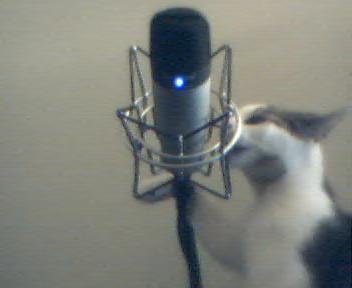We’re going to take a look at some simple and free ways to improve your audio productions from the start of the process.
So you would like to do a podcast, but you’re really not sure how to make it sound good. If you have a USB microphone I can give you a set of quick and simple tips to reducing the noise and making everything sound better. These tips will work for all types of mics but people who are using USB mics have a tendency to miss things and small mistakes as they happen because they are unable to monitor the audio as they speak.
Pop:
Occur when a burst of air hits the microphone diaphram, usually at the beginning of a P word, like Podcasting. Most people puff their P’s, which means they exhale a lot of air at the beginning of the P sound. To avoid getting this pop on your audio track move the microphone away from the direct stream of the air. The best and simplest trick i have seen is to point the mic directly at the tip of you nose, and talk into the base of the mic. This way most of the sound can be recorded but there is no air directly puffing onto the mic.
Yet another quick and simple solution is to create a simple pop filter, a piece of thin cloth to disrupt the flow of air from your mouth to the microphone. You can do this simply by taking an old wire coat hanger and wrapping it around a coffee can to create a hoop, then stretching one of those disposable nylon socks that are given away in the shoe stores over the hoop and placing it in front of your mic, works very well with USB Mics, Regular mics, pretty much anything.
Breathing:
Breath normally, its perfectly fine to have a breath sound, most people need to breath to surrvive so whether you think so or not as long as you aren’t sighing, people don’t even notice the breathing noises. In fact studies have show people tend to dislike audio when the breaths are edited out, it makes people think the entire sentence is a run on and can actually lead to some truly sensitive people to hold their breath until a pause in the audio. breath naturally for the good of your listeners!
Wheezing & Yawning:
Most people don’t realize this but talking can strain your vocal chords, talking non stop for long periods of time doubly so. It is normal for your throat to wheeze a little bit when you’re on a pretty long show, so I always keep a glass of water next to the mic, and try to take a sip, nothing more in between segments. Breaking your show up to give you time to breath not only helps audience members follow the action but also gives you a short second for a quick drink.
Why Water? I’m a coffee powered show why not a good sip of coffee? Well certain beverages, specifically those with caffeine, or citrus juices can actually tighten your vocal cords and at least on me the make me prone to yawning when I talk. So I stick with water and everyone is happy.
 FYI:
FYI:
For the record when you get more into the production a Microphone and Mixer run into your computer is worlds away better for a couple different reasons, the first and most important of which being the ability to monitor your audio. With USB mics you can’t wear headphones and get a real time feel for how your voice sounds, otherwise known as self modulation. You naturally change the tone and volume of your voice based on how you hear yourself talk. This is one of the reasons why people talk louder on cell phones, there is no feedback mechanism like a normal landline has built in.
Find the sweet spot, record yourself in different relitave possitions to the microphone, see which sounds better. 10 minutes of prep time when you first get the mivrophone can improve your technique and overall sound tenfold over the lifetime of use.
